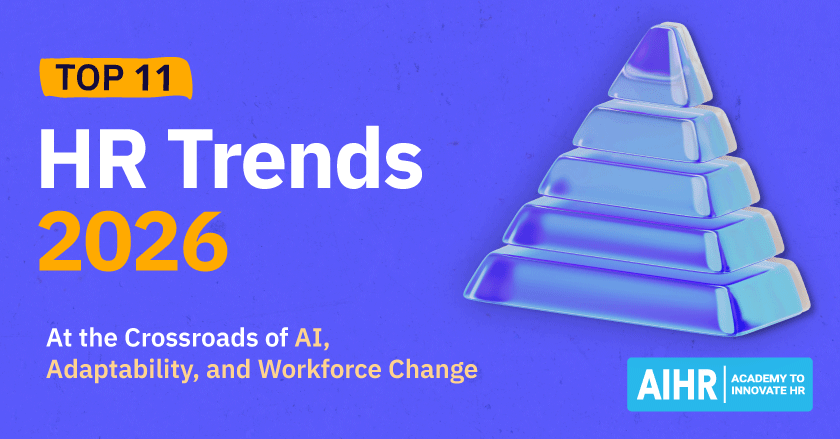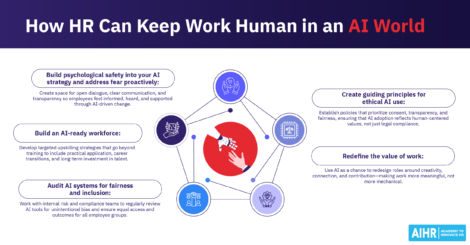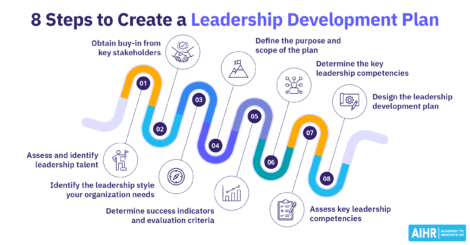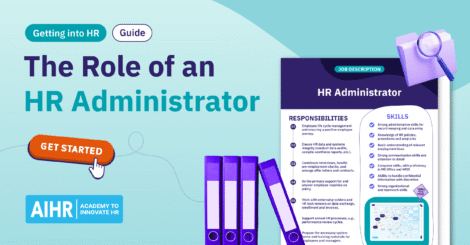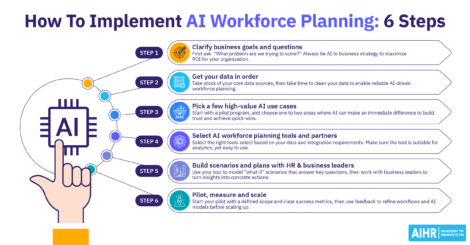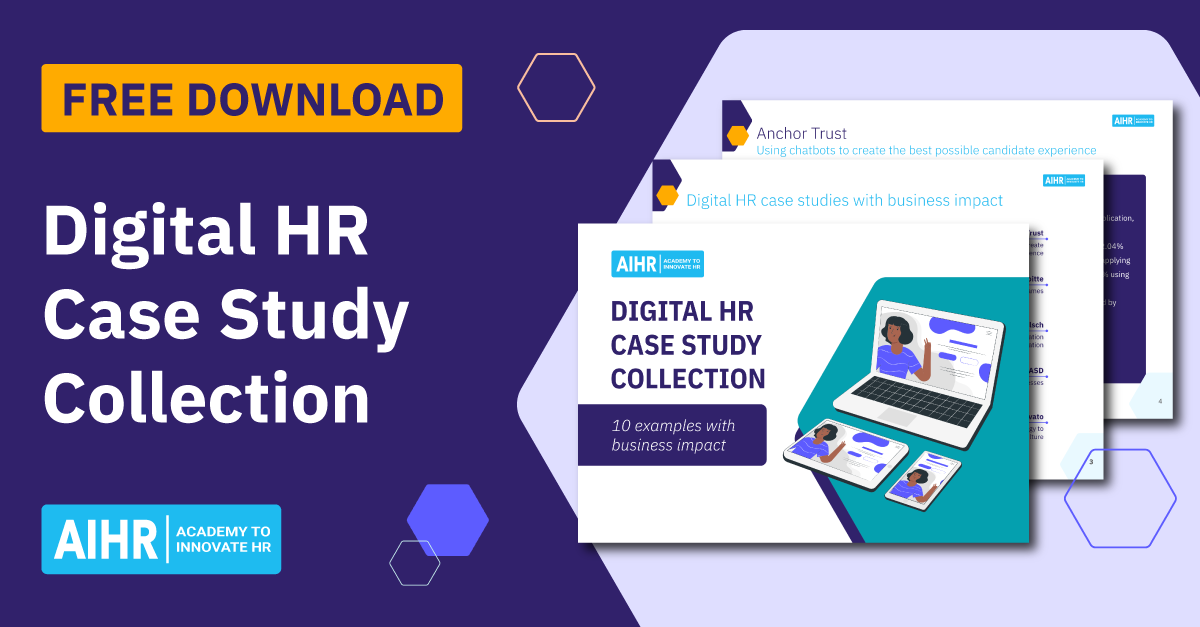Although HR tools have become increasingly more advanced, over 80% of HR leaders report not having the right HR technology, and 65% say their existing software isn’t user-friendly.
As HR takes on a stronger strategic role in organizations, spending too much time on administrative work limits its true impact. The answer lies in using the right HR tools, solutions that boost efficiency and give HR professionals more capacity to drive business results.
In this article, we’ll look at the main categories of HR tools, highlight examples of leading platforms, and provide guidance on selecting the best options for your organization.
Contents
HR analytics tools
HR AI tools
HR recruitment tools
HR tools for performance management
HR communication tools
HR automation tools
HR tools for small businesses
Free HR tools
How to choose the right HR tools
HR analytics tools
HR analytics and reporting tools save time by automating workforce planning processes and provide real-time access to data for more informed decision-making. Here are a few leading options:
- PeopleForce: Equipped with robust tools for measuring employee satisfaction. Its Employee Net Promoter Score surveys (eNPS) and anonymous feedback tools enable HR teams to analyze key drivers that influence employee engagement.
- Playroll: Useful for global organizations, this platform consolidates payroll data across countries so HR can track trends, monitor compliance, and customize workflows across regions.
- Crunchr: A people analytics platform that integrates data from various HR systems. Its intuitive, self-service analytics make complex data accessible even to non-technical users. A standout feature is its storytelling dashboard, which turns raw data into compelling visual narratives.
- Medallia: Provides real-time feedback, actionable insights, and predictive analysis. Combining employee and customer data helps HR teams make evidence-based decisions to improve the employee experience.
- Tableau: Known for advanced data visualization, Tableau supports multiple formats such as motion charts, boxplots, and bullet charts. It also allows data blending, aggregations, and calculations, making it a powerful tool for analyzing complex datasets.
HR AI tools
AI tools are transforming HR by making routine tasks faster and more effective, freeing teams to focus on higher-value work. Today’s AI-powered platforms touch almost every part of HR administration:
- Lattice: A people management platform with AI-driven features for real-time feedback, performance review support, engagement survey analysis, and even identifying potential retention risks.
- GoodTime: Designed for high-volume recruiting, GoodTime uses AI to streamline interview scheduling. It allows HR teams to connect with candidates through text, WhatsApp, and email, and even automates candidate feedback.
- Fuel50: An AI-powered talent management solution focused on career development and internal mobility. It creates personalized skill-building plans and offers a talent marketplace to help employees explore growth opportunities.
- UiPath: Specializes in automating repetitive HR tasks such as resume screening, onboarding, and employee data management through AI-driven bots and digital agents.
- Eightfold AI: A talent intelligence platform that uses AI to match candidates with jobs, forecast future skill needs, and support internal mobility.
- HireVue: Specializes in AI-powered video interviewing and assessment, analyzing speech and facial data to help identify top candidates more efficiently.
HR recruitment tools
Recruitment has evolved far beyond manual processes. Modern HR recruitment tools help screen applicants, schedule interviews, and onboard new hires with far greater speed and precision.
- Greenhouse: A comprehensive Applicant Tracking System (ATS) that covers everything from candidate sourcing to interview scheduling and onboarding. Its automated and customizable features, including AI capabilities, make it especially well-suited for medium to large organizations.
- Lever: A talent relationship management platform (TRM) that emphasizes building and maintaining candidate relationships. Its “nurture” feature helps HR teams cultivate talent pipelines, run personalized recruitment campaigns, and engage passive candidates.
- Canditech: Provides customizable pre-employment testing for both technical and soft skills, including job simulations. It also includes anti-cheating measures capable of detecting AI-generated responses from tools like ChatGPT.
- Spark Hire: Focuses on one-way video interviews that allow recruiters to screen candidates quickly and reduce time-to-hire. It also supports behavioral assessments and automated reference checks to simplify the hiring process.
HR tools for performance management
Performance management tools help organizations set clear goals, collect feedback efficiently, and run smoother review processes. They also play a role in fostering continuous development and recognition.
- Engagedly: Combines performance management, employee engagement, and learning features. It offers gamified recognition, continuous real-time feedback, and tools that keep employees engaged throughout the year.
- Workhuman Conversations: Designed for cultures that value ongoing feedback. It makes it easy for employees to request check-ins and exchange feedback in real time, while also including strong social recognition features that encourage peer recognition.
- Teamflect: Built for Microsoft 365, this tool integrates directly with Teams and Outlook. It supports goal setting, development planning, performance reviews, and recognition, making it a natural fit for organizations already using Microsoft’s ecosystem.
- Betterworks: Focused on continuous performance management, it enables organizations to align goals (OKRs), provide regular feedback, and track progress.
- 15Five: Combines performance reviews, engagement surveys, and recognition features. Its weekly check-ins encourage ongoing dialogue between managers and employees.
Make HR tools work for you, not the other way around
HR professionals spend too much time managing tools instead of unlocking their full potential. The right technology should streamline processes, reduce admin, and free you to focus on strategy—not create more work.
With AIHR’s Digital HR 2.0 Certificate Program, you will:
✅ Master how to evaluate, select, and implement HR tools effectively
✅ Learn to automate and streamline key HR processes for maximum efficiency
✅ Build digital HR skills to turn technology into a strategic advantage
✅ Future-proof your HR career with practical, hands-on learning
🎓 Move beyond admin-heavy workflows and use digital HR to drive real business impact.
HR communication tools
Strong communication keeps employees connected and informed, whether they’re in the office, working remotely, or in the field. These tools improve collaboration and reduce reliance on unnecessary meetings.
- Connecteam: A mobile-first platform designed for non-desk employees in industries like retail, construction, and transportation. It enables organizations to share company updates, training materials, and messages directly through its app.
- Slack, Microsoft Teams & Google Meet: Popular collaboration tools that combine messaging, video conferencing, and file sharing. They also integrate easily with HR apps, making it simple to share announcements, policies, and reminders in one place.
- HR Chatbots (Leena AI, Paradox’s Olivia, Happyfox): Available 24/7, these chatbots automate routine support tasks. They can answer common questions, guide employees through HR forms, and even assist candidates, reducing the time HR spends on repetitive inquiries.
- Staffbase: A mobile-first employee communication tool often used by companies with large frontline or distributed workforces. It supports internal news, push notifications, surveys, and employee directories.
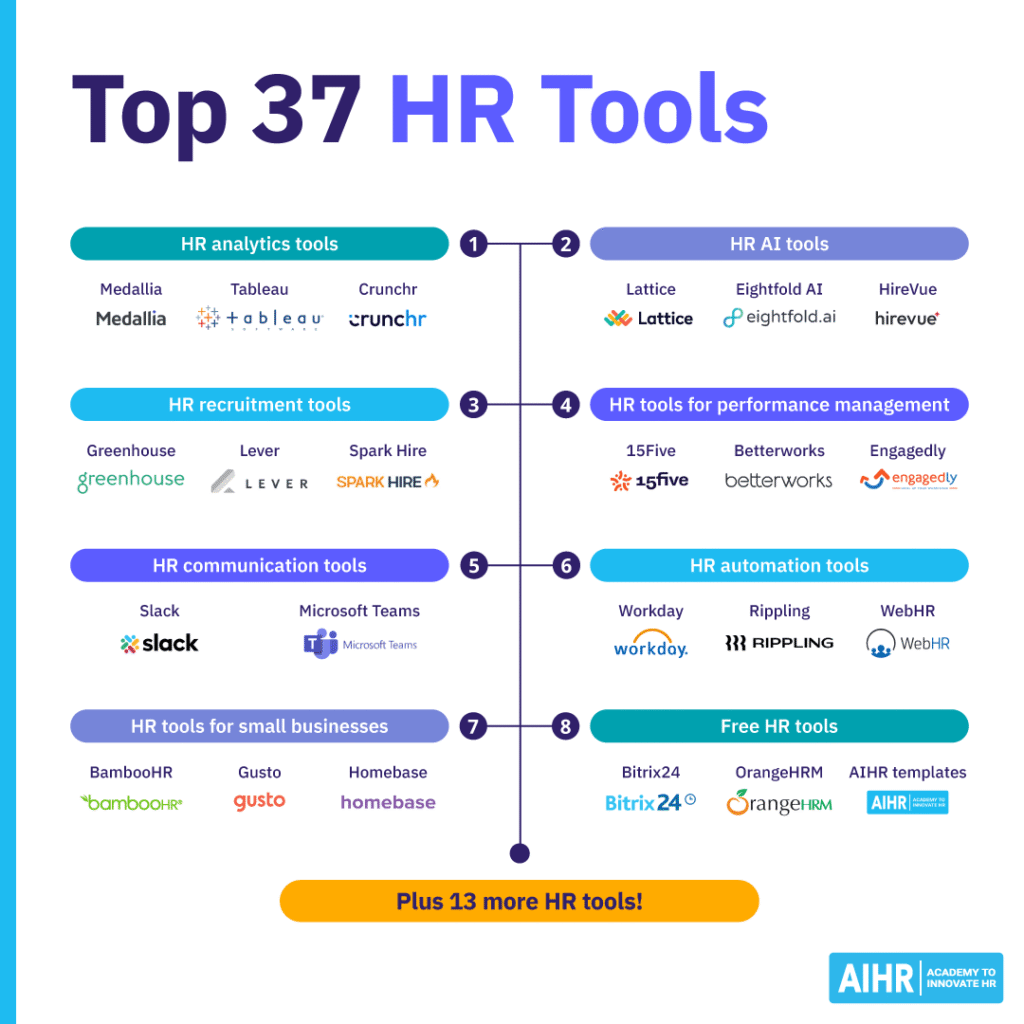
HR automation tools
Automation tools reduce the time HR teams spend on repetitive tasks like time tracking, payroll, and onboarding. By handling routine administration, these platforms give HR more time to focus on strategy.
- Rippling: A highly customizable workforce management solution that handles payroll, time tracking, automated workflows, and reporting. It also integrates with more than 600 third-party apps.
- WebHR: A cloud-based platform ideal for multinational companies. It supports payroll and benefits administration across multiple countries and includes features for onboarding, performance reviews, time tracking, and attendance.
- Workbright: Focused on simplifying the onboarding process. It automates compliance management and helps new hires complete employment, payroll, tax, and background verification documents, including I-9 verification.
- Workday: A full-suite HR platform best suited for large enterprises. It automates processes across talent acquisition, compensation, benefits, time tracking, workforce planning, and analytics.
HR tools for small businesses
For small HR teams, efficiency and ease of use are essential. The right tools can streamline day-to-day administration while staying affordable and scalable as the business grows.
- BambooHR: A popular HRMS for small to mid-sized companies. It centralizes employee data and includes features for applicant tracking, payroll, time and attendance, and performance management. Its scalability makes it a solid option for growing organizations.
- Gusto: Known for its simplicity, Gusto is best for companies with fewer than 150 employees. It covers automated payroll, benefits administration, hiring and onboarding, and time tracking in one intuitive platform.
- Homebase: Ideal for businesses with hourly staff in retail, hospitality, or services. The app makes scheduling and time tracking easy, helping managers handle shift work without complicated setups.
- OnPay: Goes beyond payroll by automating federal, state, and local tax calculations, as well as onboarding tasks. Its employee self-service portal reduces administrative questions by letting staff update their own profiles.
- Deel: Designed for global and remote-first companies. Deel simplifies international hiring, contract management, payroll, and compliance, making it easier for small businesses to expand across borders.
Free HR tools
Not every HR team has the budget for paid platforms, and fortunately, there are free tools that can support essential HR tasks. While they don’t always offer the full depth of paid solutions, they can be a practical starting point for small teams or organizations exploring new options.
- Bitrix24: A collaboration platform that includes employee directories, absence management, file sharing, and team communication features, all available in its free plan.
- OrangeHRM (Open Source): A widely used open-source HR system offering recruitment, performance, and leave management modules. Flexible, but may require IT support for customization.
- Confluence (Free for up to 10 users): A go-to tool for building internal HR wikis, policies, and onboarding hubs.
- AIHR free templates & resources: Beyond software, AIHR offers a wide range of practical HR templates that help professionals save time and improve consistency in their work. Examples include a performance improvement plan template, a 30-60-90 day plan template, a training needs analysis, and an HR investigation form. These resources provide structured, ready-to-use frameworks that can be adapted to fit your organization’s needs.
And this is just the start. The AIHR blog offers even more free HR tools, templates, and resources designed to help you save time, improve processes, and make a bigger impact in your role.
How to choose the right HR tools
Now that you have a robust list of the best HR tools, what’s the next step? Choosing the right ones that fit your HR teams’ and organization’s needs. Follow these essential steps
1. Identify your needs
The first step is to be clear about what you expect the tool to accomplish. For some organizations, this may mean automating payroll or attendance tracking. Others may prioritize better analytics, recruitment support, or communication features.
Document these needs and translate them into a list of functional requirements. At the same time, review your current systems. You may already have overlapping functionality in place, and understanding where the true gaps are will help you narrow down options.
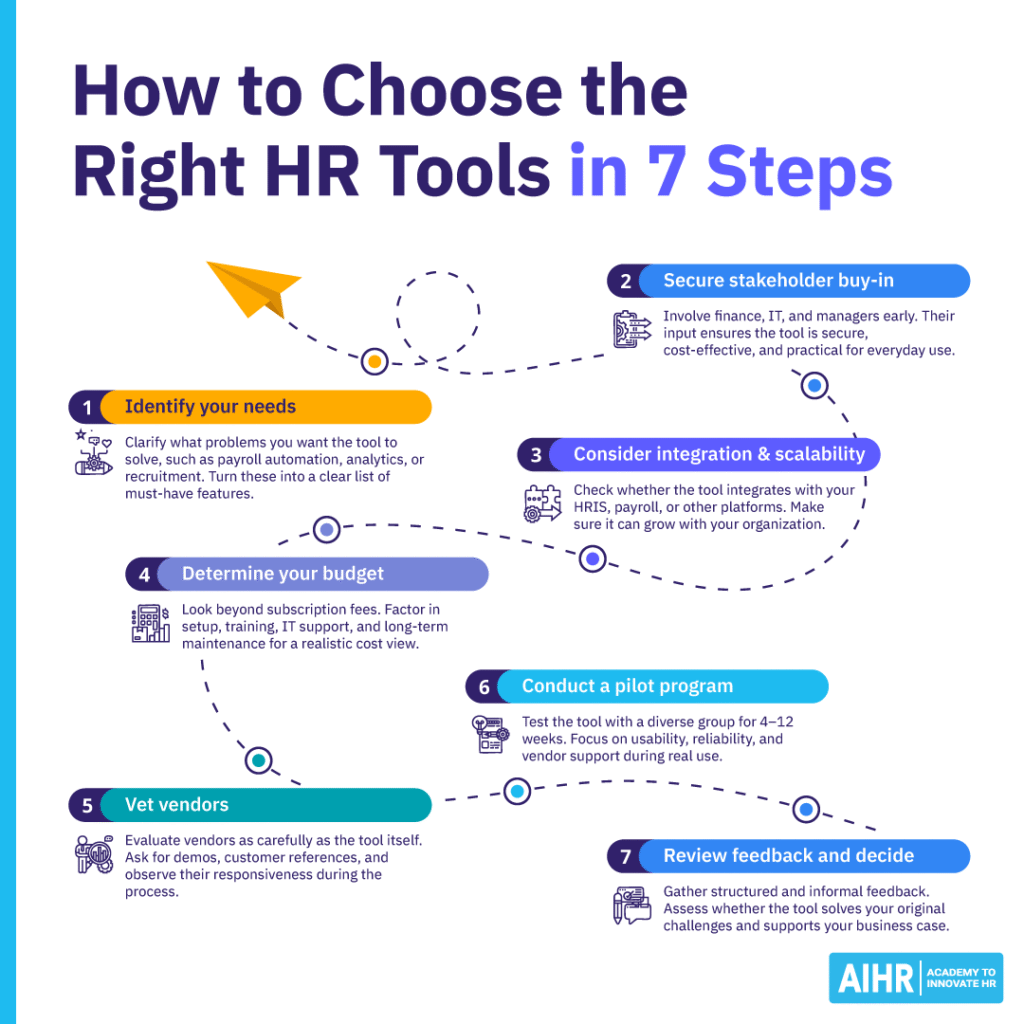
2. Secure stakeholder buy-in
HR technology touches more than just the HR team. Finance will want to review costs, IT will assess security and compatibility, and line managers will look at usability. Involving them early not only improves the quality of the evaluation but also helps with adoption later.
Consider forming a small cross-functional group to test tools, compare notes, and flag issues. This collective approach also builds credibility when you present a final recommendation.
3. Consider integration and scalability
Tools that cannot integrate with existing systems quickly create inefficiencies. During evaluation, ask vendors to demonstrate how their product connects to your HRIS, payroll, or communication platforms. Don’t rely solely on sales claims — request a live demo of integrations.
Scalability is equally important. A solution that works well for 200 employees may fall short when your workforce doubles. Assess whether the tool can support long-term organizational growth, expansion into new regions, or changes in strategic focus.
4. Determine your budget
Subscription fees rarely tell the whole story. Other cost factors include:
- Implementation and data migration
- Training for HR staff and employees
- Ongoing IT support
- System upgrades and maintenance.
Mapping out the total cost of ownership allows you to compare tools realistically and avoid budget overruns after implementation.
5. Vet vendors
Vendor reputation and reliability matter as much as product features. Go beyond online reviews by requesting case studies, speaking with current clients, and asking for references in your industry.
Pay attention to the vendor’s behavior during the evaluation. Are they transparent about limitations? Do they provide timely answers? A vendor that communicates clearly before the sale is more likely to provide reliable long-term support.
6. Conduct a pilot program
Instead of rolling out the tool company-wide, start with a pilot involving a diverse group of users. Depending on its complexity, this may run anywhere from four to twelve weeks.
During the pilot, focus on:
- The quality and speed of vendor support when issues arise
- How intuitive the tool is for different types of users
- Whether it performs consistently under daily workloads.
7. Review feedback and make a decision
Feedback should be both structured and informal. Surveys and focus groups will give you measurable input, while casual conversations often reveal real frustrations or unexpected benefits.
Compare the findings against your original requirements. Does the tool resolve the issues you set out to fix? Does the business case still hold when considering user adoption and hidden costs? These questions will guide your final decision.
HR tip
Don’t forget about frontline, remote and contract employees when choosing online HR tools. They can provide valuable, often overlooked considerations like accessibility, usability, and mobile functionality before you finalize the selection process.
Before you go
Now that you have this overview of the best HR tools. What’s the next step? Consider which ones on the list would meet both your HR and business needs. When it comes to costs, ensure you go beyond subscription or licensing fees. Consider the total costs, such as integration, employee training, and IT support, to choose HR tools that will deliver long-term ROI.


